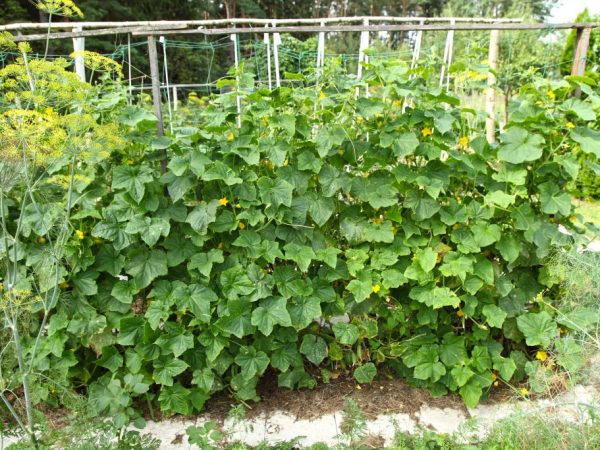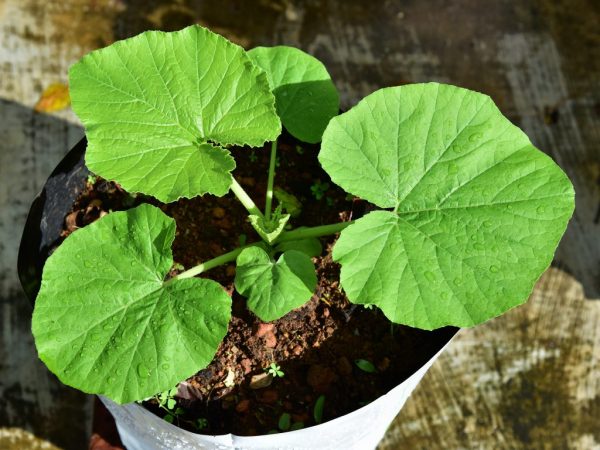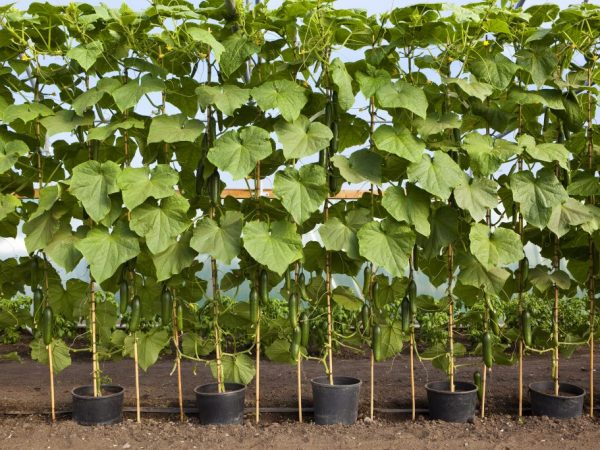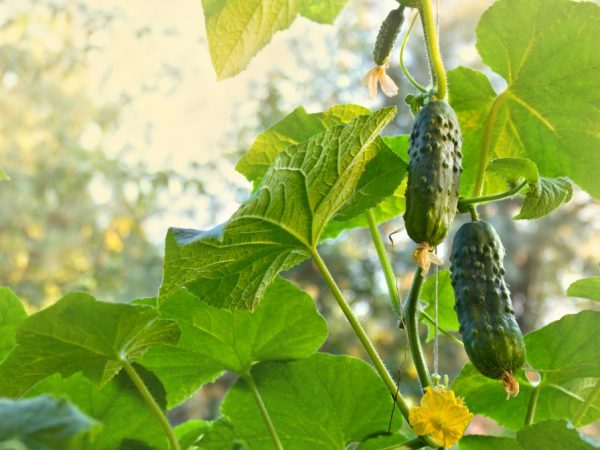Homemade vertical cucumber beds
The size of the plot or the quality of the soil does not always allow growing vegetables. There are many original ways to get a bountiful harvest from a small garden. How to make vertical cucumber beds? Let's take a closer look at the simplest technologies that are available to novice farmers.

Homemade vertical cucumber beds
Why is such a construction needed?
Each farmer tries to use the site with maximum benefit, so he often experiments and shows imagination. Knowing the intricacies of cultivating a warm and moisture-loving vegetable, you can easily create acceptable conditions for growth and fruiting. The structure is made individually for the needs of the gardener.
pros
A vertical cucumber bed saves the time required for planting maintenance. Thanks to the simple design, comfortable conditions for irrigation and weed control are created. The scourge of the plant is positioned at such an angle that it does not obstruct the view during harvesting.
Minimal contact with open soil prevents the occurrence of common species ailments. Compact beds do not take up much space, so they will be relevant on a site of any size. If you give preference to mobile options, then you can rearrange the structures in any part of the garden or yard, saving them from heat or cold.
"Cucumbers on a vertical bed are well protected from rotting, soil particle contamination, rodent encroachment."
The main disadvantages of vertical cucumber beds include the rapid drying of the soil and the lack of nutrients. Not all farmers can be near their plantings every day, which provokes a drying out of the coma. You don't have to buy a complex drip system to ensure regular irrigation - it's easy to do it yourself.
For vertical structures made of wood, it is better to give preference to the "external" system. The surface of a plastic bottle is pierced with a needle and placed between the vines. The liquid flows down the walls and irrigates the plantation.
Minuses
However, not everything is so positive and the technique has its negative sides. Due to the limited volume of soil, the soil dries quickly. If it is not possible to irrigate plants every day, then it is necessary to equip a drip irrigation system. Farmers often add hydrogel to the substrate, which retains moisture and later gives it to the bushes.
In limited containers, nutrients are quickly washed out from cucumbers. To provide the culture with all the necessary microelements, it is necessary to apply fertilizers (root and leaf) twice a week. It is important to choose the right concentration of drugs, giving preference to natural remedies.
A small volume of soil freezes quickly in cold weather. The vegetable is a thermophilic crop, so the roots instantly react to glaciation of the earth.If you do not take care of covering materials during cultivation, then a light frost will destroy all work.
Economy options
Vertical homemade cucumber beds can be used both on the garden plot and on the balcony. Simple suspended structures do not take up much space, therefore they are suitable for plantations of limited size. They can be easily fixed to a fence or tied to a railing.
From bottles

You can plant cucumbers in plastic bottles.
Plastic containers from under the water or old buckets quickly adapt for growing greenery. We advise you to take containers with a volume of at least five liters, otherwise you will not create optimal conditions for the development of culture. Drain holes are made in the bottom of the tanks, after which they are poured in layers in the following sequence:
- drainage (expanded clay, broken bricks);
- compost;
- sandy earth;
- fertile soil.
Cucumbers can be grown both by seedlings and by planting in the soil. Before planting, the mixture is watered, after which they begin agricultural work. The containers can be easily moved to a suitable place or covered with polyethylene from frost. A stick is buried next to each bush, along which they check the need for irrigation.
Plastic bottles have long been a versatile raw material and are used in many areas of modern life. A two liter capacity will provide one plant for three days. To do this, small holes are made on the sides, and the balloon itself is buried in the ground when planting seedlings. It is important that the surface of the device is in contact with the roots. It is enough just to add moisture to the neck, and the cucumber will take the necessary water by itself.
From bags
From dense bags for garbage or cereals, you can equip original vertical beds for your cucumbers. The containers are twisted in several places in the form of "pockets". Each bag is filled with a nutrient mixture made from soil, compost and drainage. The planting structures are fixed on the balcony railing or netting, after which they begin to plant the seedlings.
To protect the plants from overheating, we recommend covering the structure with foil. The material reflects the sun's rays, so you don't have to worry about vegetables on hot days. Overgrown vines twine around the fence, making harvesting easy.
From the barrel
As a basis, you need a plastic or metal container, on the surface of which holes are made for seedlings, at intervals of 15 cm. Drainage, soil and compost are poured, trying not to tamp. Trellis made of laths or thin tubes are installed above the barrel.
As the plant develops, the cucumber branches are tied to ropes, lifting them off the ground. Watering is carried out both from the top and from the sides. To keep the surface warm, we recommend painting it white.
From tires
Planting cucumbers vertically will also work in a structure assembled from old car tires. The material is stacked both on top of each other in the form of a flat tower, and chaotically. The mixture is poured inside in the following sequence:
- expanded clay;
- compost with sand;
- Earth.
Holes are made in the walls of the tires, into which the seedlings are then planted. With this design, we do not recommend growing cucumbers by direct sowing into the ground. Often young bushes grow inside the rubber, which reduces the quality of the future harvest.
From flower pots

You can install the garden anywhere
Volumetric containers folded in several rows are a great option for a homemade garden bed. The structure can be fixed on a post or a withered tree. Cucumbers do not have such a developed root system as tomatoes, so they grow well in regular flower pots.
Seeds are planted directly in the ground or using the seedling method. The advantage of the technology is full mobility, which allows you to establish a "plantation" anywhere on the site. However, it is worth remembering that the soil dries out quickly and you need to water it more often.
Wood options
If you want to make a reusable vertical bed with your own hands, then it is better to give preference to wooden structures. The soil in such structures does not dry out as quickly as in the above methods. Plants grow naturally and do not suffer from root overheating.
From old furniture
A chest of drawers is ideal for planting cucumbers. The interior item is sanded and then covered with a layer of fresh paint. After the surfaces are dry, the shelves are pulled out, fixing in a comfortable position.
A composite with soil and compost is poured into each seat. In the soil, holes are made in which seedlings are planted or seeds are sown. Water gently so that the liquid does not spread along the ground. For drainage in boxes, we recommend punching drainage holes.
Made of wood
With your own hands, you can assemble a garden bed from scrap materials. From boards with a thickness of at least 0.15 cm, boxes of the desired size must be put together. The lower "tier" should be the widest, and the upper one - the narrowest. If you fold all the boxes, you get a stepped pyramid, up to half a meter deep. Drainage with soil mixture is poured inside, after which cucumber bushes are planted.
The garden bed is installed on the site, after which a tent made of rails is nailed down next to it. The lower bar is fixed at a level of 70 cm from the ground. Polyethylene is fixed on the upper stick, which will cover the structure. As the lashes form, you will need ropes to tie the vines.
Reusable universal bed

You can make the garden yourself
If you are not going to move the planting, then it is better to create a fixed "plantation" that will last more than one year. When choosing a material, we advise you to pay attention to high-quality raw materials that are not afraid of heat and frost. Regular feeding will protect the soil from nutrient leaching.
From a double pipe
With your own hands, you can make a vertical structure from available tools. As a base, you need a wide plastic "riser" and a thin tube. Holes are perforated on two-thirds of the surface of the material: the diameter for large ones is up to 20 cm, and for small ones - no more than 1 cm.
Both parts are folded into one another, after which the drainage is poured. The soil is added gradually, trying not to tamp. Irrigation will be carried out through an internal structure. Seedlings are planted in the holes, after which they are installed vertically. The result is a row of pillars in the sun.
In such a bed, weeds almost do not start, therefore, as a care, only watering and applying mineral dressings. To prevent the building from overheating, we recommend painting the surface white. Developing lashes will fall, excluding tying on a trellis. The crop does not rot and is available for harvest at any time.
From the grid
The chain-link has long been a favorite material for gardeners. Fences and shelters are built from it, and with a minimum of physical strength, it will be possible to assemble a vertical bed. As raw materials, you need to take:
- mesh;
- dry grass;
- film;
- priming.
The chain-link is bent in the form of a tube, the diameter of which is about 0.9 m. The ends are fixed, and polyethylene is placed under the bottom. The structure on the sides is filled with straw, after which the soil is added, mixed with compost, drainage and sand. Seedlings are planted at a distance of at least 15 cm from one another.
The grass is a natural defense against frost, so you can plant your cucumbers on time without fear. In case of subzero temperature conditions, the plantation is hidden under a covering material. By the way, for summer residents who cannot water often, we recommend covering the bed with foil instead of straw.
Hut
Trellis, like those of grapes, can also be made for woven vegetables. To do this, a place is found on the site for a structure. Pillars are buried in the ground (two rows on the sides and a large one in the center), on which the whips will be attached. For stability, it is better to concrete it, and then proceed to the rest of the work.
The "roof" is made of slats or a net, along which the plant will weave. The culture can be planted in open ground or in mobile container pots. The undoubted advantages of the option are the decoration of the site and the convenience for harvesting: the greens do not lie on the ground, therefore they are visible with the naked eye.
Growing homemade vegetables often requires the gardener to have enough free space. Cucumbers in a homemade vertical bed are a great option for small areas. Our recommendations contain the most popular types of designs.


